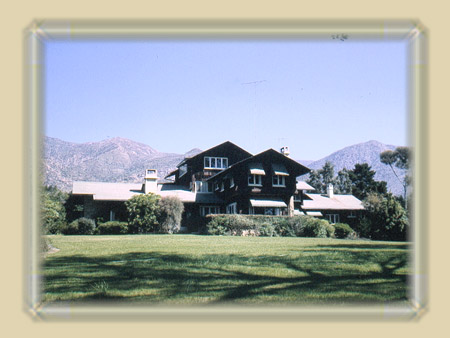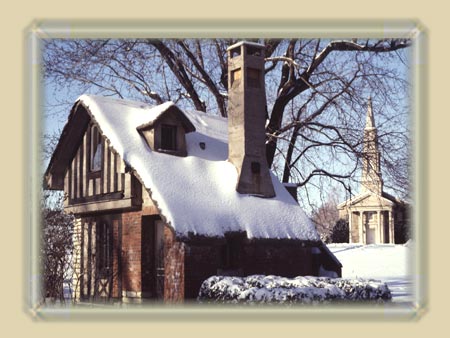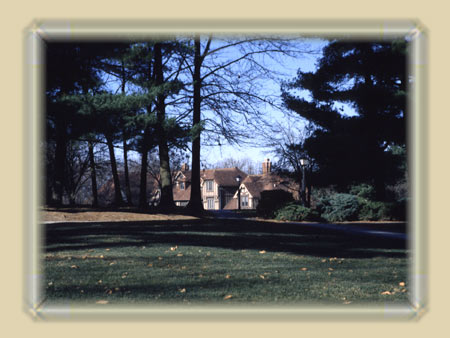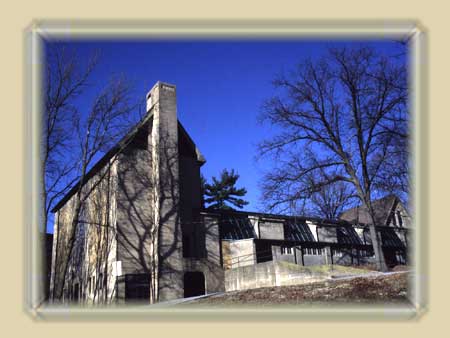Final Phase of Career
The Principia College Historic District represents the final phase of the career of Bernard Maybeck (1862-1957) as a designer of houses and public buildings, and as an architect significantly involved in campus planning and design for educational institutions. A recent poll of the American Institute of Architects ranked Maybeck ninth on a proposed list of the ten greatest architects this country has produced. As early as 1949, Lewis Mumford said, “But for Bernard Maybeck’s fine reticence, his work would have been hailed long ago as the West Coast counterpart of Wright’s prairie architecture.”

- Bernard Maybeck (1862-1957), 1924
In 1983, Richard Longstreth summed up his views on Maybeck’s importance:
Maybeck also had an impact on the future. His individualism has been a major source of inspiration to designers in the Bay Area from the early twentieth century to the present. His rustic buildings in particular have fostered a local tradition. At its best, this tendency has furthered San Francisco’s role as an architectural center. . . . San Francisco has been one of the few places where several generations of modernists have looked to a tradition-oriented architecture from the recent past for ideas. (On the Edge of the World: Four Architects in San Francisco at the Turn of the Century, 354)
The Principia College commission was a principal focus of Maybeck’s career from 1923 to 1940 when his connection with the College ended. Maybeck worked on three academic communities during his long career. Early in his practice he administered the international competition for the Phoebe A. Hearst Architectural Plan for the University of California. He did not produce a master plan himself, but he did design several buildings for the University early in his career-most notably the faculty club-and he collaborated with Julia Morgan on the Hearst Memorial Gymnasium. In the early 1920s, he sketched out a plan for Mills College in Oakland, but few of his ideas were actually used.
The Principia College commission, on the other hand, kept Maybeck’s office functioning through the Great Depression, and the plan was substantially carried out in spite of the change of site and other needed revisions. Maybeck designed 13 buildings that were constructed at Elsah, Illinois, between 1931 and 1946, and 11 of those structures are still standing. The concentration of Maybeck buildings on the Elsah bluffs rivals the collection of houses of his design still surviving in the Berkeley Hills.
Maybeck’s active career spanned the years from 1885 to 1937, and he is best known today for his domestic work in San Francisco, particularly the Roos House of 1909, and for his work at the Panama-Pacific Exposition of 1915, including the Palace of Fine Arts. His First Church of Christ, Scientist, Berkeley, completed in 1910 and designated a National Historic Landmark in 1977, is considered by many to be his masterpiece in the craftsman style. In the 1920s, Maybeck carried out several commissions for Earle C. Anthony, including a large, theatrical house in Los Angeles in 1928.
From 1923 onward, his career evolved around the Principia College commission; and in the early 1930s, the work at Elsah was the mainstay of Maybeck’s office. He wrote ecstatic letters to Principia Director Frederic Morgan about how important this commission was to him-a chance to design a college where graduates could get the refinement that would help them “save the pieces when the world seems to go to smash.” The archive at the College shows, through drawings and letters, the evolution of Maybeck’s thinking on the buildings, particularly the Chapel. He convinced college administrators that an English village would “express the spirit of home, of peace, and of absolute harmony with [its] physical surroundings.” Also, Principia College was intended to foster the individuality of each student by offering dormitory rooms that were different from each other, thus avoiding the “institutional effect.”
Bernard Ralph Maybeck has been described as an architect of “mood,” and he also was a pioneer in bold construction techniques. He believed in making the ideas of the past relevant to the present. The executed buildings at Principia College show all these facets of Maybeck’s approach-from the classical Chapel to the vernacular aspects of the little Mistake House on the Chapel Green. He framed his campus buildings in modern materials-steel, concrete, gunite, and even glass blocks-and then clothed them in historical architectural dress.

- Frederic Morgan (1891-1983), c. 1940
Commission Well-Documented
The Principia College commission is exceptionally well-documented because it grew out of an association between Maybeck and Frederic E. Morgan, the director of Principia in the 1920s and 1930s. They originally met in Montecito, California, where Maybeck designed a home for Morgan’s future father-in-law, A. E. Bingham. After conferences in the Bohemian Grove of the redwoods north of San Francisco, Morgan and Maybeck developed a remarkable architect-client relationship. The physical distance between St. Louis and San Francisco meant that the two men had an extensive correspondence about all aspects of this commission. The files at Principia College include 32 years of letters, a number of transcripts of taped interviews with Frederic Morgan and the architects who worked in Maybeck’s office, many working drawings and pastel renderings representing all stages of planning the buildings, field reports, and hundreds of photographs of the construction process. In 1973 Robert M. Craig, who now teaches architectural history at Georgia Institute of Technology, wrote a 700-page dissertation at Cornell University entitled “Maybeck at Principia.”During the construction phase at Elsah, Maybeck was assisted by Edward Hussey, a graduate of the University of California School of Architecture, who worked for nearly ten years with Berkeley architect Julia Morgan. Hussey communicated regularly with Maybeck during the middle 1930s as the architect’s representative in Illinois. Hussey had a considerable influence on the construction and design phases of Morey Field House. He also designed the Writer’s Cabin and a number of faculty houses, including Knolltop, Gamble, Gertsch, and Morgan Cottage.In 1940 when Maybeck retired from the supervision of the Principia College project, he turned over much of the latter work to a Berkeley architect he knew and trusted, Henry Higby Gutterson, a graduate of the University of California who also attended the Ecole des Beaux-Arts in Paris. Gutterson reworked Maybeck’s design for Sylvester House, and also designed a number of the smaller buildings on the west side of campus: Cox Cottage, the Duplex, Beeman, Williams, and Hitchcock, in particular. His work was not as bold as that of Maybeck, but it maintained the scale and English atmosphere of the older buildings.Often Maybeck referred to himself as an artist and a lover of beauty. He believed the rolling hills of Elsah gave him a site that rivaled Heidelberg in Germany and West Point in the United States. He consciously selected an English village as the design model embodying the ideas he associated with Principia’s educational system, intending the architecture to contribute to Principia’s goal of producing constructive thinkers. Most of the executed buildings are dormitories, and they do indeed appear to have a positive effect on the students who live in them. These large buildings are located in such a way that they appear to have grown into position. A careful reading of the Craig dissertation, combined with a visit to the Principia campus, reveals the way in which a romantic architect and his sympathetic client were able to design and locate buildings that were intended to embody and transmit ideals.
Charles B. Hosmer, Jr. (1932-1993)
Professor Emeritus of History, Principia College
| Introduction | Historic District | About the Collection |









